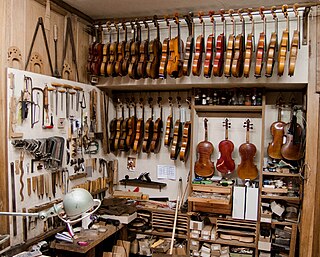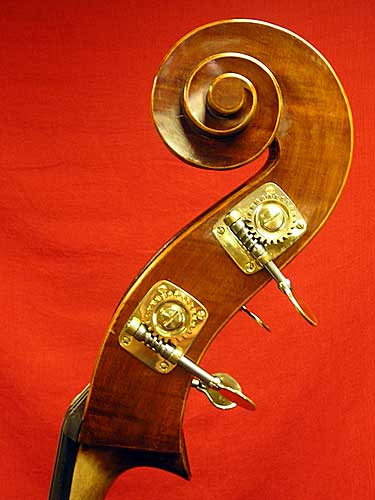
The cello ( CHEL-oh; plural celli or cellos) or violoncello ( VY-ə-lən-CHEL-oh; Italian pronunciation: [vjolonˈtʃɛllo]) is a bowed (and occasionally plucked) string instrument of the violin family. Its four strings are usually tuned in perfect fifths: from low to high, C2, G2, D3 and A3, an octave lower than the viola. Music for the cello is generally written in the bass clef, with tenor clef and treble clef used for higher-range passages.

The double bass, or simply the bass, is the largest and lowest-pitched bowed, string instrument in the modern symphony orchestra.
A scroll is a roll of parchment, papyrus, or paper, which has been drawn or written upon.

The violin, sometimes known as a fiddle, is a wooden string instrument in the violin family. Most violins have a hollow wooden body. It is the smallest and highest-pitched instrument (soprano) in the family in regular use. Smaller violin-type instruments exist, including the violino piccolo and the pochette, but these are virtually unused. The violin typically has four strings, usually tuned in perfect fifths with notes G3, D4, A4, E5, and is most commonly played by drawing a bow across its strings. It can also be played by plucking the strings with the fingers (pizzicato) and, in specialized cases, by striking the strings with the wooden side of the bow.

The viola ( vee-OH-lə, alsovy-OH-lə, Italian: [ˈvjɔːla, viˈɔːla]) is a string instrument that is bowed, plucked, or played with varying techniques. It is slightly larger than a violin and has a lower and deeper sound. Since the 18th century, it has been the middle or alto voice of the violin family, between the violin (which is tuned a perfect fifth above) and the cello (which is tuned an octave below). The strings from low to high are typically tuned to C3, G3, D4, and A4.

The cittern or cithren is a stringed instrument dating from the Renaissance. Modern scholars debate its exact history, but it is generally accepted that it is descended from the Medieval citole. It looks much like the modern-day flat-back mandolin and the modern Irish bouzouki, and is descended from the English guitar. Its flat-back design was simpler and cheaper to construct than the lute. It was also easier to play, smaller, less delicate and more portable. Played by all classes, the cittern was a premier instrument of casual music-making much as is the guitar today.

A Hardanger fiddle is a traditional stringed instrument used originally to play the music of Norway. In modern designs, this type of fiddle is very similar to the violin, though with eight or nine strings and thinner wood. Four of the strings are strung and played like a violin, while the rest, aptly named understrings or sympathetic strings, resonate under the influence of the other four.

Tar is an Iranian long-necked, waisted instrument, shared by many cultures and countries including Iran, Azerbaijan, Armenia, Georgia, and others near the Caucasus region. The older and more complete name of the tār is čāhārtār or čārtār, meaning in Persian "four string",. This is in accordance with a practice common in Persian-speaking areas of distinguishing lutes on the basis of the number of strings originally employed. Beside the čārtār, these include the dotār, setār, pančtār, and šaštār or šeštār.

A tailpiece is a component on many stringed musical instruments that anchors one end of the strings, usually opposite the end with the tuning mechanism.

A variety of methods are used to tune different stringed instruments. Most change the pitch produced when the string is played by adjusting the tension of the strings.

Making an instrument of the violin family, also called lutherie, may be done in different ways, many of which have changed very little in nearly 500 years since the first violins were made. Some violins, called "bench-made" instruments, are made by a single individual, either a master maker, or an advanced amateur working alone. Several people may participate in the making of a "shop-made" instrument, working under the supervision of a master. Various levels of "trade violin" exist, often mass-produced by workers who each focus on a small part of the overall job, with or without the aid of machinery.

A violin consists of a body or corpus, a neck, a finger board, a bridge, a soundpost, four strings, and various fittings. The fittings are the tuning pegs, tailpiece and tailgut, endpin, possibly one or more fine tuners on the tailpiece, and in the modern style of playing, usually a chinrest, either attached with the cup directly over the tailpiece or to the left of it. There are many variations of chinrests such as clamped to the body in the center, on either side of the tailpiece as with a Guaneri style chinrest or to the left of the tailpiece.

Playing the violin entails holding the instrument between the jaw and the collar bone.. The strings are sounded either by drawing the bow across them (arco), or by plucking them (pizzicato). The left hand regulates the sounding length of the strings by stopping them against the fingerboard with the fingers, producing different pitches.
The neck is the part of certain string instruments that projects from the main body and is the base of the fingerboard, where the fingers are placed to stop the strings at different pitches. Guitars, banjos, ukuleles, lutes, the violin family, and the mandolin family are examples of instruments which have necks. Necks are also an integral part of certain woodwind instruments, like for instance the saxophone.

The dramyin or dranyen is a traditional Himalayan folk music lute with six strings, used primarily as an accompaniment to singing in the Drukpa Buddhist culture and society in Bhutan, as well as in Tibet, Sikkim and Himalayan West Bengal. It is often used in religious festivals of Tibetan Buddhism. The instrument is played by strumming, fingerpicking or plucking. The dramyen, chiwang (fiddle), and lingm (flute) comprise the basic instrumental inventory for traditional Bhutanese folk music.

A bridge is a device that supports the strings on a stringed musical instrument and transmits the vibration of those strings to another structural component of the instrument—typically a soundboard, such as the top of a guitar or violin—which transfers the sound to the surrounding air. Depending on the instrument, the bridge may be made of carved wood, metal or other materials. The bridge supports the strings and holds them over the body of the instrument under tension.

The lavta is a plucked string music instrument from Istanbul.

The choghur is a plucked string musical instrument common in Azerbaijan and Georgia. It has 4 nylon strings.

A tromba marina, or marine trumpet is a triangular bowed string instrument used in medieval and Renaissance Europe that was highly popular in the 15th century in England and survived into the 18th century. The tromba marina consists of a body and neck in the shape of a truncated cone resting on a triangular base. It is usually four to seven feet long, and is a monochord. It is played without stopping the string, but playing natural harmonics by lightly touching the string with the thumb at nodal points. Its name comes from its trumpet like sound due to the unusual construction of the bridge, and the resemblance of its contour to the marine speaking-trumpet of the Middle Ages.

The quinton is a bowed musical instrument, chordophone, in use mostly in France in XVIIIth century. It takes its name from the fact that, in ensembles, it played the quinta vox or quintus. Another derivation of the name may be from the number of strings and for consonance with violon. By the same name it is sometimes denoted the pardessus de viole, an originally six-stringed instrument of the family of the viols, since the pardessus lost one string and adopted the same tuning of the quinton. However, while the pardessus is viol-shaped, the quinton is violin-shaped.



















